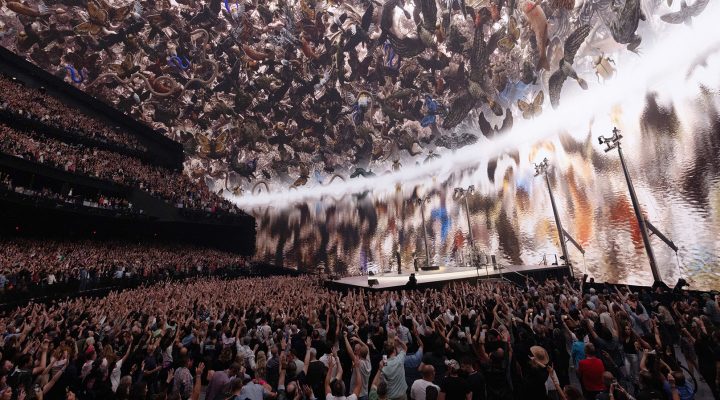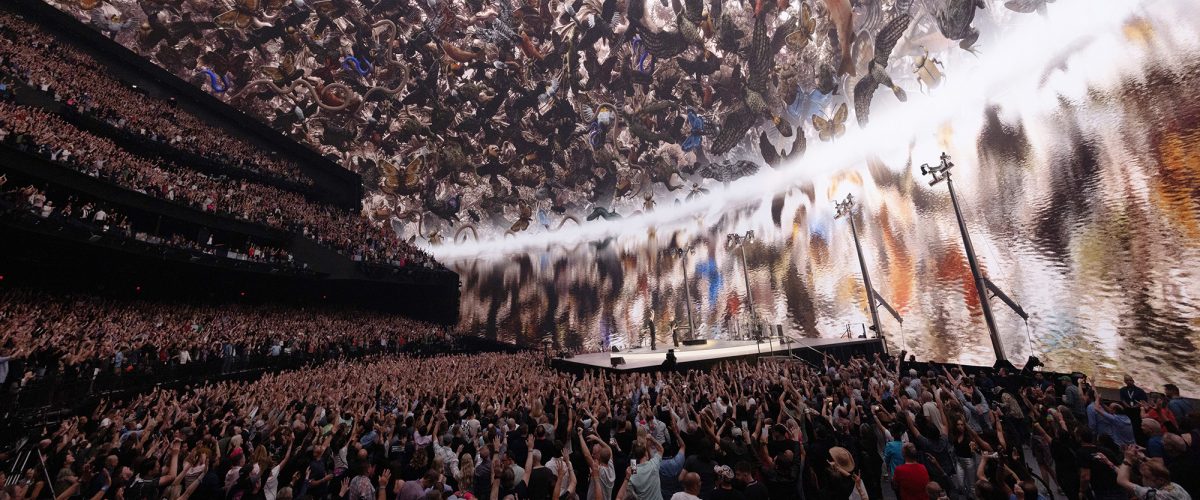People could perhaps be forgiven for cynically receiving U2’s 2023 Super Bowl ad announcing a Las Vegas residency inaugurating The Sphere as an indication that almost five decades after their 1976 founding, the Irish rock band has arrived at semi-retired irrelevance.
After all, isn’t Vegas where musical acts/singers/artists go to die? But in the aftermath of attending the Oct. 7 show with my family, I’m happy to report the band is still very much the same out-ahead-of-where-the-culture-is-headed artists who gave the world the 1992-93 ZooTV Tour promoting their Achtung Baby album, which the current U2:UV shows revisit and play in full.
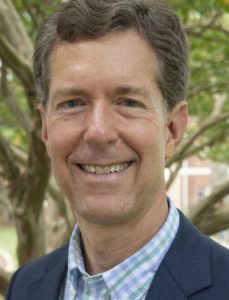
Steven Harmon
They also are at the pinnacle of their musicianship, despite the temporary replacement of drummer Larry Mullen Jr. by Bram Van den Berg of the Dutch band Krezip while Mullen recovers from surgeries to mend the toll the decades of drumming in a rock band have taken on his body.
And they are still the unabashed practitioners of Christian theological reflection on the world whose 1983 War album first made me a U2 fan as a high school student then beginning to sense a calling to ministry. The concerts of the U2:UV residency feature some of the most sophisticated slanted truth-telling in which U2 has engaged in their live shows, even while sometimes doing so in less circuitous fashion (H/T Emily Dickinson) than was true during the ZooTV Tour.
‘There is room for everyone’
In retrospect, that Super Bowl ad last February previewed themes U2 would explore theologically in their shows at The Sphere. Opening excerpts of news broadcasts reporting on climate crisis-related meteorological phenomena are heard by U2 fans around the world before their transportation to the Nevada desert. Later in the ad, the “Space Baby” (the Achtung Baby redux) delivers to them a message from beyond, now repeated during the residency by the baby from the exterior outer surface screen of The Sphere (called the “Exo-Sphere”): “There is room for everyone.”
Once concertgoers make their way through the “Exo-Sphere” to the interior of The Sphere, they may have the realization that the setting for the show looks vaguely familiar. As artist and former art teacher Kelly Eddington notes on X, the opening visual in U2’s shows at The Sphere in Las Vegas evokes the Pantheon — a pagan temple repurposed as a church in AD 609. (In fact, when I was posting my own photo of the Pantheon-esque initial interior screen image of The Sphere on Facebook, the app offered me “Rome” as a check-in option.) Some have looked up toward the top of the dome and noticed also a convincingly real-looking video-generated white dove fluttering about before the opening of the concert. Is it the Spirit ready to hallow the space we inhabit? In any case, we’d spot a significant reappearance of the dove later in the show.
“Is it a Psalm-like lament directed to the God who seems absent? Or is it God looking for hiding humanity?”
But first, there would be something of an invocation of this Spirit. In the first two legs of the ZooTV tour in 1992, Bono would walk to the microphone and before the first song “Zoo Station” sing this to a tune in the style of Irish “sean nós” singing with roots in North Africa: “I … I could have lost you / I … I could have let you go / Slipping through the cracks / Slipping through the cracks.” When the band takes the stage in the U2:UV shows, Bono reprises this, but with a lyrical alteration: “I … I couldn’t find you / I … where are you hiding from me? / Alone … and not alone / Alone … and not alone.”
Is it a Psalm-like lament directed to the God who seems absent? Or is it God looking for hiding humanity? In either case, our lonely selves are about to discover we are not alone.
In an interview on CBS Mornings that aired the day before the U2:UV shows began, artist and stage designer Es Devlin said her “marching orders” from U2 for her contributions to the show were “to create a cathedral … in Las Vegas.”
By “Even Better than the Real Thing,” the third song in the set list, Bono would explicitly own up to the theme, pointing to the praying hands clutching a dangling crucifix visible at the conclusion of the accompanying video art highlighting the connections of Elvis Presley with Las Vegas and declaring, “Elvis has not left this building! Not just an Elvis chapel — an Elvis cathedral we have for you!” (This was not the first time U2 had transformed a concert space into a symbolic worship space. The stage for the 2009-2011 U2 360 Tour was inspired by La Sagrada Familia Basilica in Barcelona, Spain, and the band chose to launch the tour in that city.)

Bono, The Edge, Adam Clayton and Bram van den Berg of U2 perform during U2:UV Achtung Baby Live at The Sphere on September 30, 2023, in Las Vegas, Nev. (Photo by Kevin Mazur/Getty Images for Live Nation)
From pagan to sacred
But back to the beginning of the concert. The show’s opening image of the interior wall of the Pantheon — the pagan temple that would be transformed into a church — also evokes another wall, the people-dividing Berlin Wall that had come down before U2 arrived in East Berlin in October 1990 on the eve of German reunification for the recording sessions in Hansa Studios for what became the Achtung Baby album. Upon its release, Bono said the album was “the sound of four men chopping down The Joshua Tree,” their unprecedentedly successful 1986 album that then necessitated their reinvention.
The Edge’s opening guitar riff of the album’s first track, “Zoo Station,” functioned as the sound of a chainsaw felling the iconic southwestern U.S. desert plant that supplied the double entendre of that previous album’s title (Jesus in Hebrew is “Joshua,” and there are multiple references to the “Jesus tree” — the cross — in the songs of that album).
“Bram’s drum fills are functioning as the pounding of the sledgehammers bringing down the Berlin Wall dividing people from one another.”
In the studio recording and ZooTV versions of “Zoo Station,” each instance of the opening guitar riff was followed by Larry’s drum fills. In the U2:UV opening, substitute drummer Bram’s drum fills precede the guitar riff, occasioning opening night online speculation that Bram was coming in too early. That was put to rest when the drum fill kept coming first night after night. This was intentional, for now Bram’s drum fills are functioning as the pounding of the sledgehammers bringing down the Berlin Wall dividing people from one another—or are they opening up fissures that bring light through the wall that divides the church from the world?
I was reminded of a biblical text: “For he is our peace; in his flesh he has made both groups into one and has broken down the dividing wall, that is, the hostility between us … that he might create in himself one new humanity in place of the two, thus making peace and might reconcile both groups to God in one body through the Cross, thus putting to death that hostility through it” (Ephesians 2:14-16).
Each pounding of the drums initiates cracks in the wall facing us.
A bit of dusty light begins to spill through the cracks a little left of center in a vaguely cruciform pattern, joined by more light-emitting cracks opening up elsewhere with each successive drum fill. And then, suddenly, bright white light pours through to form a cross with vertical portion extending from the stage to the top of the dome and horizontal transept stretching across the width of the screen above the stage. Keen eyes recognized its inspiration: architect Tadao Ando’s Church of the Light in Japan that Bono previously visited.
The pagan temple is now reconsecrated, and we are in the midst of a “cathedral … in Las Vegas.” (And what does Bono do the Sunday morning after the first two nights of welcoming the masses to this “cathedral … in Las Vegas”? Go to a literal cathedral in Las Vegas.)
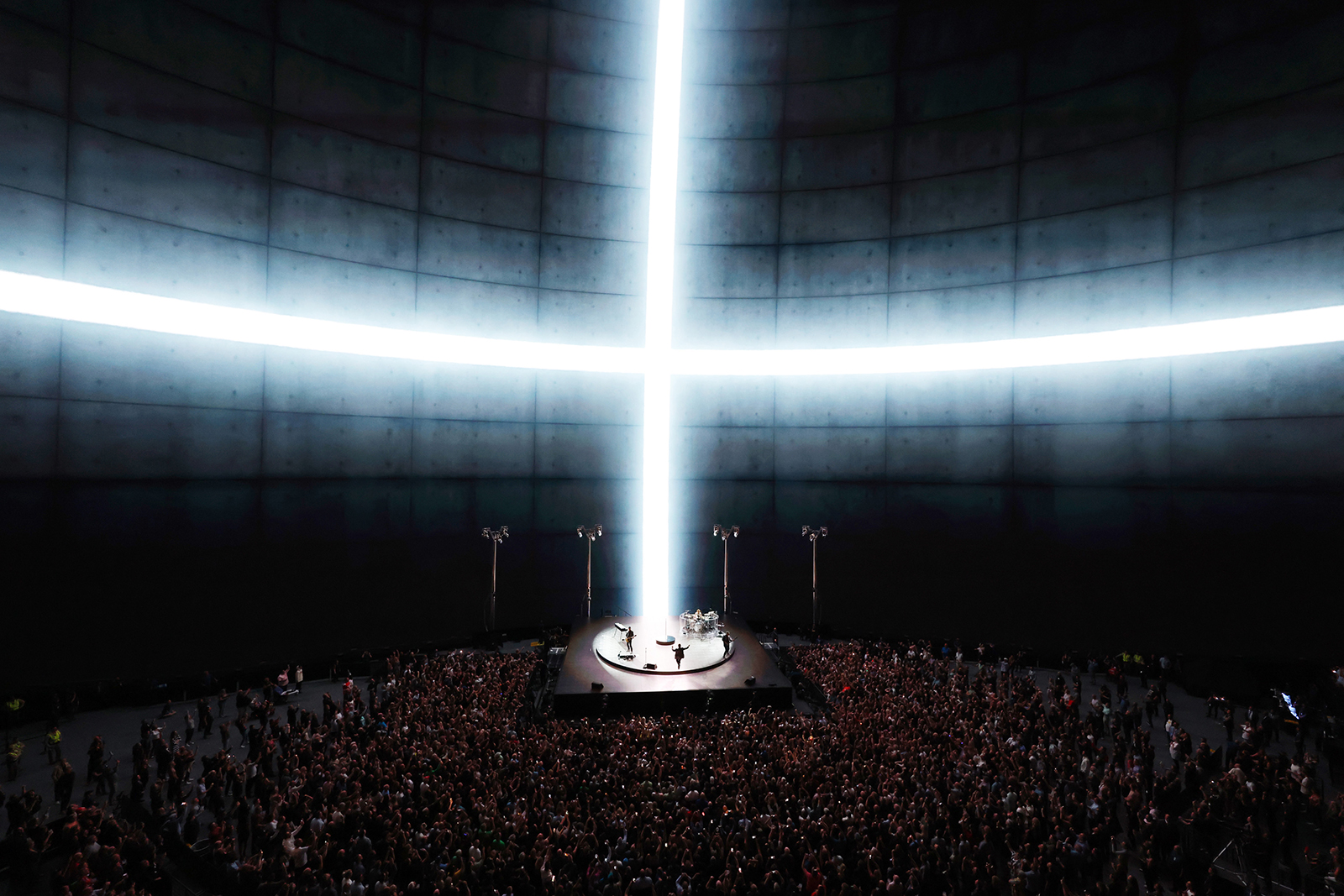
Bono, The Edge, Adam Clayton and Bram van den Berg of U2 perform during U2:UV Achtung Baby Live at The Sphere on September 30, 2023, in Las Vegas, Nev. (Photo by Kevin Mazur/Getty Images for Live Nation)
Our betrayal
After playing “Zoo Station,” “The Fly” (which uncannily anticipated the existential epistemological angst of our fake-news-saturated present moment three decades ago), “Even Better Than the Real Thing,” Mysterious Ways” and “One” the band launches into “Until the End of the World,” in which Judas narrates in the first person his confrontation with Jesus between the Crucifixion and Resurrection.
Two days before our own concert experience, I was viewing over breakfast video footage of the performances of this song in the first two concerts. I had just finished reading the text of Pope Francis’s Apostolic Exhortation “Laudate Deum: To All People of Good Will on the Climate Crisis” issued the previous day, and suddenly all the interconnections of an overarching theme of these concerts dawned on me. After the deliciously ironic segue to “Until the End of the World” provided by Bono’s cover of Elvis Presley’s “Love Me Tender” while John F. Kennedy’s “We Choose to Go to the Moon” speech and the launch of a Saturn V rocket set up a God’s-eye perspective on the earth, we are immersed in images portraying rising sea levels that progressively seem to threaten to submerge the members of the band. Worsening meteorological effects appear on multiple inset screens around The Sphere. Toward the end of the song, these images give way to the consummation of things by fire and a burning red flag, following up on the lyrical climax of the song: “In waves of regret and waves of joy, I reached out for the one I tried to destroy / you said you’d wait until the end of the world.”
We are Judas, and God’s earth is Jesus.
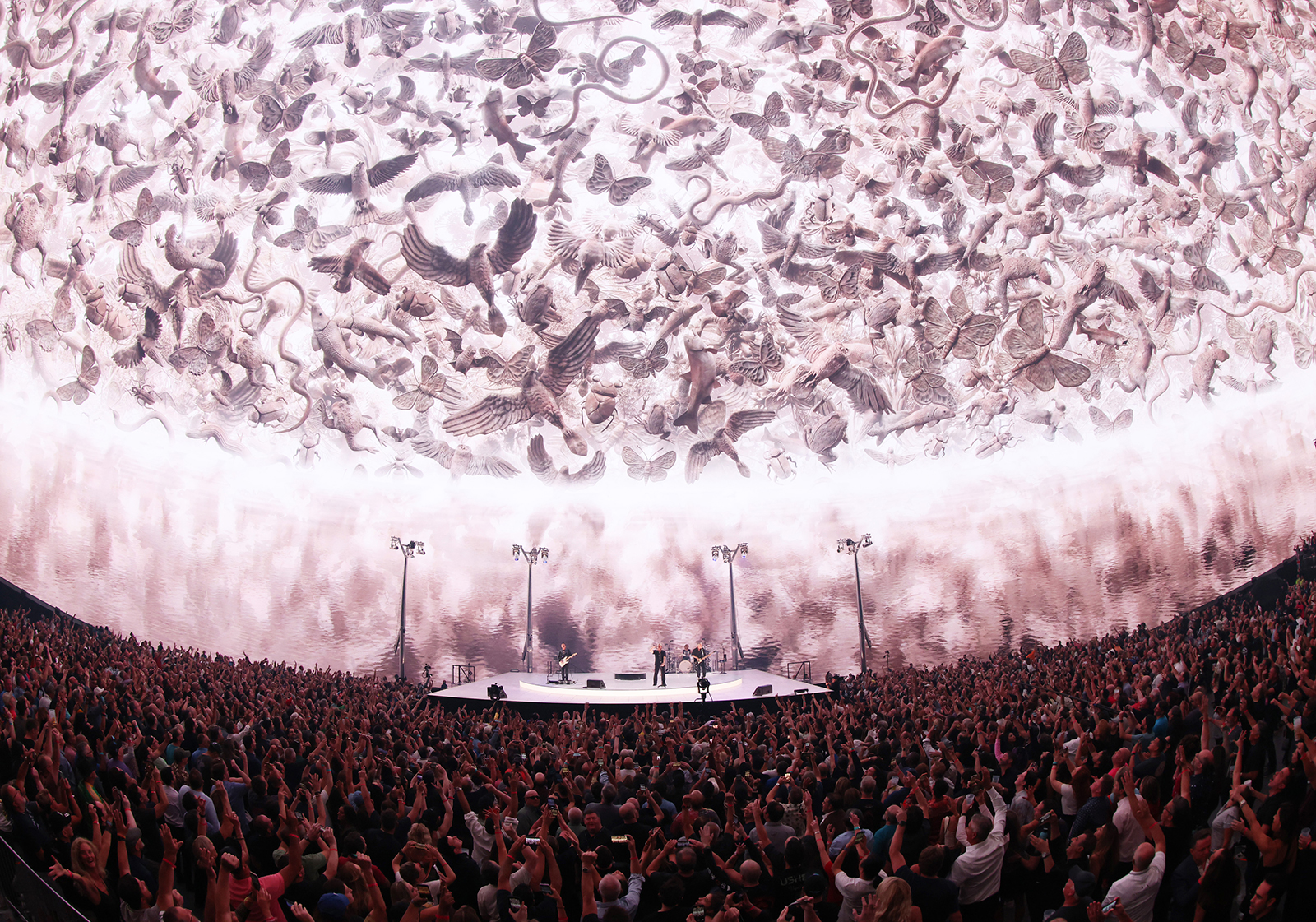
Bono, The Edge, Adam Clayton and Bram van den Berg of U2 perform during opening night of U2:UV Achtung Baby Live at The Sphere on September 29, 2023, in Las Vegas, Nev. (Photo by Kevin Mazur/Getty Images for Live Nation)
‘Embers of Pentecost’
The red flag will reappear, for the show isn’t finished addressing the climate emergency or referencing various dimensions of its larger theological framework. “Side 1” of Achtung Baby continues with “Who’s Gonna Ride Your Wild Horses?” which includes the lyric “Heaven’s white rose, the doors you open / I just can’t close.”
The sparks of the burning world at the end of the previous song seem to have become what my wife remarked to me looked like “the embers of Pentecost” descending on the band and crowd. At the end of the song, Bono works in a snippet of “We Are Climbing Jacob’s Ladder.” This part 1 set concludes with a playful rendition of “Trying to Throw Your Arms Around the World” that features the renewal of marriage vows between the fans, represented at this show by Melissa from Venezuela, with Bono making pledges on behalf of the band that include the vow “to always obey the divine guidance of the king … in however the divine is expressed” before pushing Melissa in a swing at the end of a rope tied to a (virtual) balloon rising into the heavens.
‘Political yet sexual’
Between the two album sides is a set of three to four songs with a rotating focus on other albums. In the case of our Oct. 7 show, we were treated to acoustic arrangements of songs from multiple albums preceding Achtung Baby: “I Still Haven’t Found What I’m Looking For,” “Pride (in the Name of Love)” — a song inspired by the witness of a Baptist minister — “Angel of Harlem” and connecting back to “Pride,” “MLK” (Baptists in the house this evening).
Bono introduced the “Side 2” Achtung Baby set by observing that “in a strange way it’s our most political album, and yet it’s purely sexual.”
This multivalence makes sense of much of U2’s music well before and after Achtung Baby: relationships of human love are simultaneously glimpses of the love of divine relationality. This was the best instinct of the patristic and Medieval allegorical reading of the Song of Songs, and it lends depth to Bono’s revelation on opening night of U2:UV during the middle set that “All I Want Is You” was an attempt to write a wedding song from a woman’s point of view. We also can hear it as the expression of God’s deepest desire for us: “All I want is you.”
Earlier in this show, we heard this connection between the relationships of our sexual selves and the divine relationality in “Mysterious Ways.” In this third act of the concert, we hear it in “So Cruel” (which incidentally mentions “God’s holy dove”), in “Acrobat” (which includes “I’d join the movement, if there was one I could believe in / I’d break bread and wine, if there was a church I could receive in”), and in “Ultraviolet” (“your love was a light bulb hanging over my bed”).
Then we hear the album’s final song, “Love Is Blindness,” which resonated chillingly with our experience of learning throughout the day bits and pieces of the horrors of the attacks of Hamas in Israel earlier that morning, for the background of the song was the demonic love for a cause expressed in an IRA bombing during The Troubles of Northern Ireland: “A little death without mourning, no call and no warning / Baby, a dangerous idea that almost makes sense.” (The song also featured the musical highlight of the concert for this Edge-emulating electric guitar hobbyist: The Edge’s heart-rending extended guitar solo.)
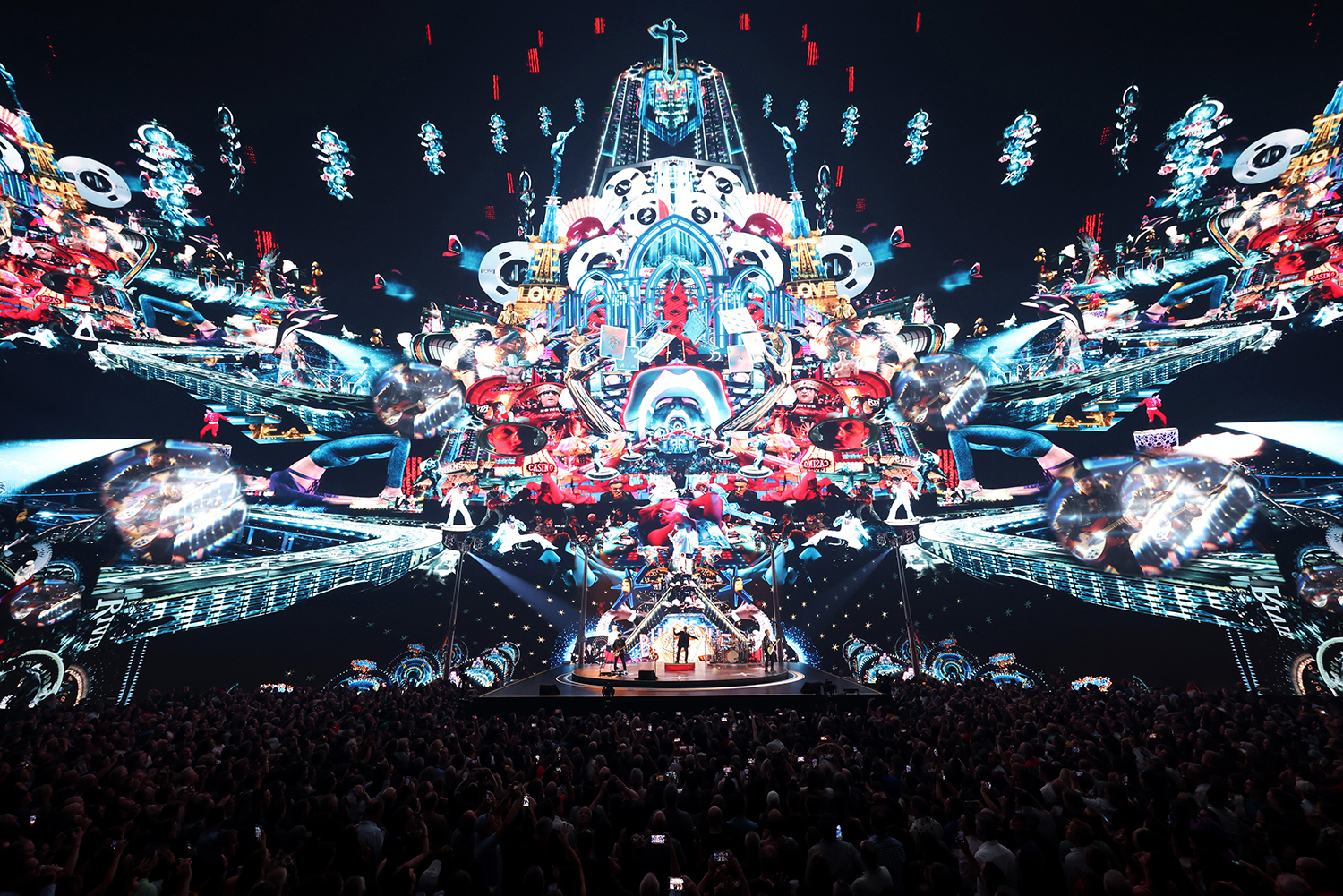
Bono, The Edge, Adam Clayton and Bram van den Berg of U2 perform during opening night of U2:UV Achtung Baby Live at The Sphere on September 29, 2023, in Las Vegas, Nev. The band performs in front of “King Size,” a work created by Marco Brambilla using generative AI technology. (Photo by Kevin Mazur/Getty Images for Live Nation)
Atomic City
The encore set begins with the familiar and fun “Elevation” (remember that link between human sexuality and divine love?) and then introduces a new song written specifically for this residency: “Atomic City,” a reference to an earlier nickname for Las Vegas, which had been released as a single and video on the morning of opening night. Hardly an insubstantial one-off, the song invites the audience to personal participation in the show’s larger narrative. In an interview in the Apple Music-produced video “Behind U2’s Residency at Sphere Las Vegas,” Bono said the song is in the tradition of a “Come-All-Ye” Irish ballad. Its lyrics issue multiple invitations in this “Come all …” format and ask a Vegas-themed question: “Are we betting on a future that’s long gone?”
Faith is a high-stakes wager, and in the context of the show the stakes are nothing less than the future of the earth.
“Atomic City” continues: “Come all who serve above and below / Come all believers and all who don’t know … Let me dive into your eyes and blah, blah, blah … Sinatra swings / A choir sings / Love is God and God is love / And if your dreams don’t scare you, they’re not big enough … I’m free / It took me my whole life / I got the keys to the cages / I’m ready for bright light / I’m free / I came here for the fight / I’m front row in Las Vegas / And there’s a big one on tonight.”
The temptations
Believers and agnostics alike are invited to the inarticulate ecstasy of intimacy with their lover, divine and/or human (remember again that human love/divine love connection?). Bright white light long has been a symbol for encounter with the divine in U2 shows, and we’re being readied for another such encounter later in the encore. When the band was in Las Vegas in 1987 to film the video for “I Still Haven’t Found What I’m Looking For” on Fremont Street, they joined Frank Sinatra at Caesar’s Palace to watch the fight between Marvelous Marvin Hagler and Sugar Ray Leonard. Now Bono is inviting us to occupy front-row seats for a fight in which everything is at stake — and in which we are not merely spectators but contestants.
We then find ourselves in the middle of the fight in “Vertigo,” a song rooted in the wilderness temptations of Jesus. We’re transported by the accompanying video imagery to the Nevada desert to do battle with our own temptations. “All of this” — the earth and its resources — can be ours, and we’re tempted to think that “no one gets hurt” if we exploit them.
Some concertgoers have found the transition from “Vertigo” to “Where The Streets Have No Name,” which since 1987 has been the sine qua non song of U2 concerts, a bit odd, but it makes sense in light of the thematic arc of the show. After the temptations of “Vertigo,” we see again the red flag from the conclusion of “Until the End of the World.” But this time the red flag is flying in the Nevada desert at dawn. As the sun rises above the horizon and The Edge begins chiming that anthemic arpeggiated guitar riff, the flag turns white and becomes the white flag of surrender — the laying down of our weapons of violence against the earth and its creatures. And then a full band instrumental crescendo brings us our eschatological bright light encounter (but not the final one for the evening).
“Where the Streets Have No Name” is followed by “With or Without You,” which is accompanied by Es Devlin’s video art installation “Nevada Ark” featuring images of 250 endangered species of Nevada that are threatened by climate change. A body of water appears in the desert (is it Lake Mead?), and a spherical ark makes its way toward shore (“through the storm we reach the shore”). When it arrives, it opens up to reveal the creatures (perhaps in a return or restoration from God’s future of what we have destroyed in our historical existence?), along with more eschatological light, in what was the most intensely emotional moment of the concert for me.
The living God will not live as God without all creation. And we cannot live without all creation, either.

Bono, The Edge, Adam Clayton and Bram van den Berg of U2 perform during opening night of U2:UV Achtung Baby Live at The Sphere on September 29, 2023, in Las Vegas, Nev. (Photo by Kevin Mazur/Getty Images for Live Nation)
Bringing it home
The final song, “Beautiful Day” has all sorts of eschatological connections, originally in association with the Jubilee 2000 third world debt cancellation campaign. The images of the creatures of a reconciled creation remain from the end of “With Or Without You,” but they continue to appear in monochrome until their turn to color is timed with the lines in the bridge: “See the world in green and blue / all these creatures right in front of you.” In the midst of the creatures is the return of the bright white cruciform light, with the cross’s transept stretching across our eschatological horizon. The bridge continues: “See the bird with the leaf in her mouth / After the flood, all the colors came out.”
During the Oct. 11 show, before “Beautiful Day,” Bono introduced each member of the band and then introduced himself: “My name is St. Peter, and welcome to heaven!” he said, while gesturing upward to the images of the endangered species of Nevada. Then at the crescendoing climax of the final chorus, again looking up toward the images of “all these creatures — right in front of you,” Bono shouts, “Beautiful! You’re beautiful! All God’s creatures, great and small — beautiful! Look atcha! Beautiful!”
At the end of the song in our Oct. 7 show, Bono sang part of “What a Wonderful World” (written by Bob Thiele and George David Weiss and recorded by Louis Armstrong). Some concertgoers who looked upward at this point again noticed the white dove fluttering about near the top of the dome — the “bird with the leaf in her mouth.”
As the band leaves the stage and the crowd leaves The Sphere, we’re sent out with a prerecorded postlude that may well be a song in progress for the long-rumored Songs of Ascent album that would continue and probably conclude the series of albums that includes Songs of Innocence and Songs of Experience (although similarly titled, the recent retrospective Songs of Surrender doesn’t really belong to this series of new-material albums). This was the case with the song “Soon (Kingdom of Your Love)” that played before the band took the stage for the U2 360 concerts 2009-2011. At any rate, the song we’re hearing includes the phrases “glorify, glorify,” “let your heart be full,” and “expect a miracle.”
The wait continues — for the album, and for the full realization of miracle and fullness of heart.
In the meantime, we’ve got a wonderful world for which we must care by joining God in God’s community-making work in the world, working together toward the reconciliation of all creation in which there is room for everyone. But it’s going to be a fight, and a bet on God’s future with nothing less than God’s world at stake. Once again, U2 has drawn me into it.
And reminded me that this is not a rehearsal.
Steven R. Harmon serves as professor of historical theology at Gardner-Webb University School of Divinity in Boiling Springs, N.C. His most recent books are Baptists, Catholics, and the Whole Church: Partners in the Pilgrimage to Unityand Seeds of the Church: Towards an Ecumenical Baptist Ecclesiology (co-edited with Teun van der Leer, Henk Bakker and Elizabeth Newman). His 2010 book Ecumenism Means You, Too: Ordinary Christians and the Quest for Christian Unity draws illustratively on the music of U2 in introducing readers to the modern ecumenical movement.

